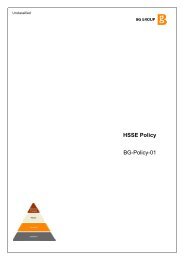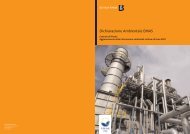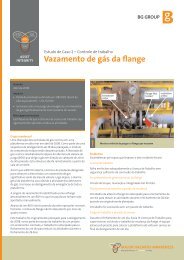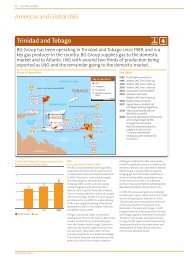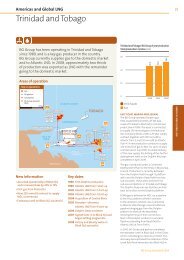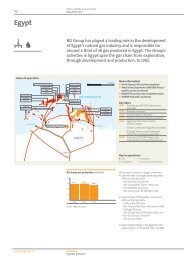HSSE Management Tours - BG Group
HSSE Management Tours - BG Group
HSSE Management Tours - BG Group
You also want an ePaper? Increase the reach of your titles
YUMPU automatically turns print PDFs into web optimized ePapers that Google loves.
3<br />
Key Integrity Barriers<br />
Topic 11 – Piping (Incl. Small Bore Piping)<br />
• Piping systems represent the conduit in a pressure<br />
containment system by which hydrocarbons<br />
and other contained fluids are transported for<br />
processing. They form critical components of a<br />
pressurised containment system and are usually<br />
the weak point in the process as a result of material<br />
degradation through a range of mechanisms,<br />
predominantly corrosion (internal or external) or<br />
erosion processes.<br />
• The critical issue in facility Piping systems is<br />
ensuring that the periodic inspections have been<br />
carried out. Because they are usually very complex,<br />
it is best to analyse and categorise piping systems<br />
using criticality (susceptibility to failure and likely<br />
consequences of failure). The inspection program is<br />
then driven by the derived criticality.<br />
• Some important areas are:<br />
– Small bore piping (< 2”) is thin walled and<br />
<strong>HSSE</strong> <strong>Management</strong> <strong>Tours</strong>:<br />
Asset Integrity Guide<br />
more susceptible to damage, and failure due to<br />
vibration. A register of small bore piping with a<br />
prescribed program of inspection is best practice.<br />
– Piping joints are particularly vulnerable. Flanges<br />
should be subject to a flange management<br />
programme to provide assurance of their quality.<br />
– Corrosion under insulation (CUI) is a key risk<br />
leading to piping failure. An assessed and<br />
documented inspection programme is needed.<br />
– Likely or expected internal corrosion mechanisms<br />
that relate to the fluids within the facility should<br />
be captured in a corrosion risk register.<br />
– Temporary repair of piping by various means<br />
(engineered clamps or wraps) may be allowed<br />
at site, however these repairs must be closely<br />
monitored whilst in place, be recorded on a<br />
register, have a maximum defined life and a clear<br />
priority for permanent repair.<br />
30



